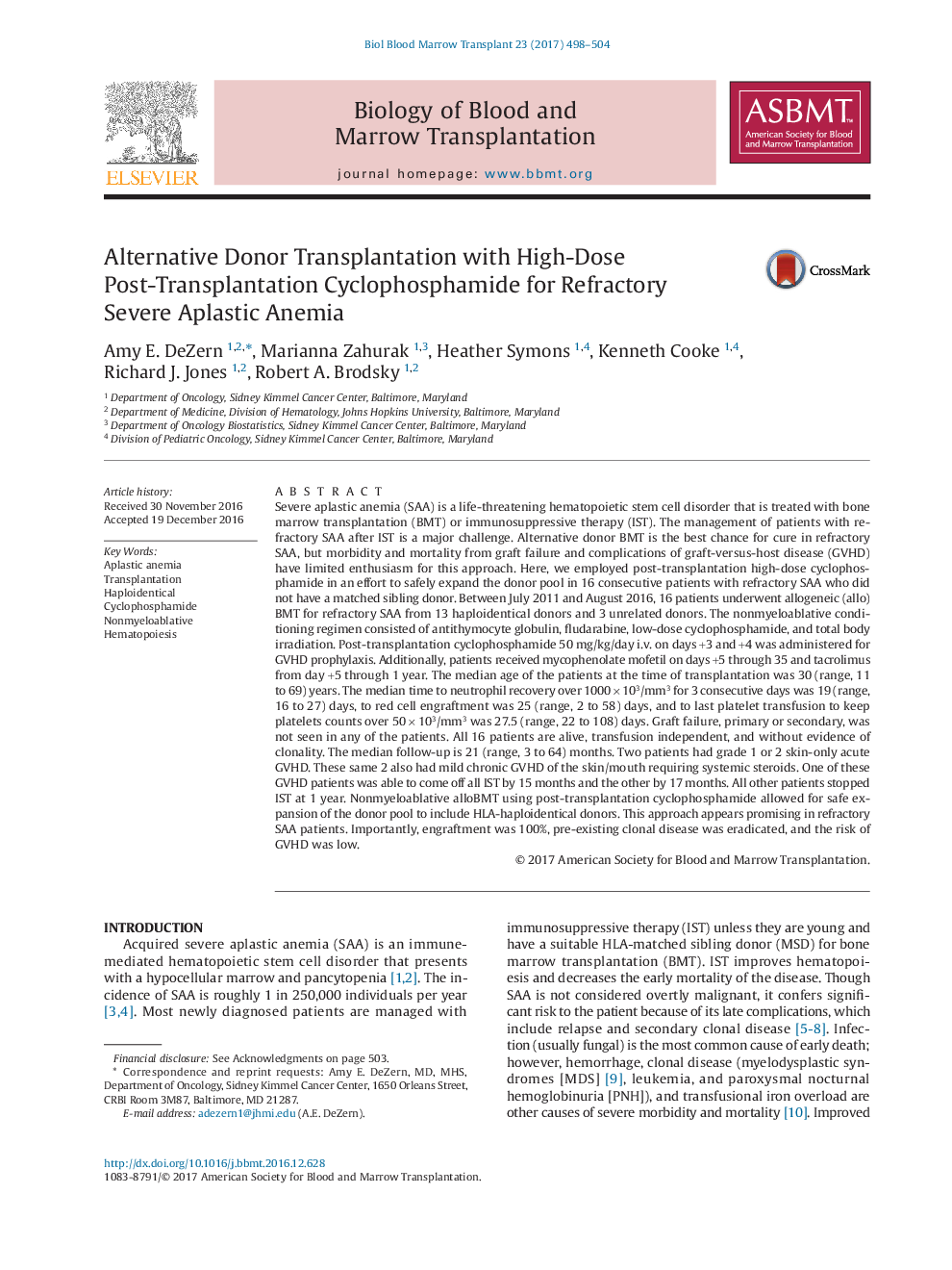| کد مقاله | کد نشریه | سال انتشار | مقاله انگلیسی | نسخه تمام متن |
|---|---|---|---|---|
| 5524223 | 1546243 | 2017 | 7 صفحه PDF | دانلود رایگان |
- We conducted a prospective trial of alternative donor transplantation for severe aplastic anemia
- The regimen contained nonmyeloablative conditioning and post-transplantation cyclophosphamide for graft-versus-host disease prophylaxis
- The regimen allows use of haploidentical and unrelated donors
- All 16 patients are alive, transfusion independent, and without evidence of clonality
- This approach will be studied as 1 arm of next Blood and Marrow Transplant Clinical Trials Network trial for relapsed and refractory severe aplastic anemia
Severe aplastic anemia (SAA) is a life-threatening hematopoietic stem cell disorder that is treated with bone marrow transplantation (BMT) or immunosuppressive therapy (IST). The management of patients with refractory SAA after IST is a major challenge. Alternative donor BMT is the best chance for cure in refractory SAA, but morbidity and mortality from graft failure and complications of graft-versus-host disease (GVHD) have limited enthusiasm for this approach. Here, we employed post-transplantation high-dose cyclophosphamide in an effort to safely expand the donor pool in 16 consecutive patients with refractory SAA who did not have a matched sibling donor. Between July 2011 and August 2016, 16 patients underwent allogeneic (allo) BMT for refractory SAA from 13 haploidentical donors and 3 unrelated donors. The nonmyeloablative conditioning regimen consisted of antithymocyte globulin, fludarabine, low-dose cyclophosphamide, and total body irradiation. Post-transplantation cyclophosphamide 50âmg/kg/day i.v. on days +3 and +4 was administered for GVHD prophylaxis. Additionally, patients received mycophenolate mofetil on days +5 through 35 and tacrolimus from day +5 through 1 year. The median age of the patients at the time of transplantation was 30 (range, 11 to 69) years. The median time to neutrophil recovery over 1000âÃâ103/mm3 for 3 consecutive days was 19 (range, 16 to 27) days, to red cell engraftment was 25 (range, 2 to 58) days, and to last platelet transfusion to keep platelets counts over 50âÃâ103/mm3 was 27.5 (range, 22 to 108) days. Graft failure, primary or secondary, was not seen in any of the patients. All 16 patients are alive, transfusion independent, and without evidence of clonality. The median follow-up is 21 (range, 3 to 64) months. Two patients had grade 1 or 2 skin-only acute GVHD. These same 2 also had mild chronic GVHD of the skin/mouth requiring systemic steroids. One of these GVHD patients was able to come off all IST by 15 months and the other by 17 months. All other patients stopped IST at 1 year. Nonmyeloablative alloBMT using post-transplantation cyclophosphamide allowed for safe expansion of the donor pool to include HLA-haploidentical donors. This approach appears promising in refractory SAA patients. Importantly, engraftment was 100%, pre-existing clonal disease was eradicated, and the risk of GVHD was low.
Journal: Biology of Blood and Marrow Transplantation - Volume 23, Issue 3, March 2017, Pages 498-504
